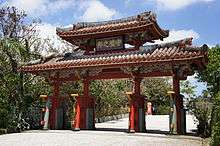Shureimon

_front.jpg)
Shureimon (守礼門) is a gate in the Shuri neighborhood of Naha, the capital of Okinawa Prefecture, Japan. It is the second of Shuri Castle's main gates. It was built in the 16th century. It was also called Shurimon (首里門, "Shuri gate") and Wī nu Aijō (上ぬ綾門, "Beautiful gate at the upper part") in the local dialect.[1][2]
The gate reflects strong Chinese influence, alongside indigenous religious traditions. The four Hanzi framed on the gate - Shu, rei, no, and kuni, which mean 'Land of Propriety' - were added to the gate long after it was built. The structure of the gate is similar to that of Chinese three-bay turret gates, and is covered with a red tiled hip roof.
The main columns are 7.94 meters apart. The top layer of the gate is 7.05 meters high, and the lower layer 5.11 meters. The 4 pillars stand on foundation stones, and they are supported on front and back by slanting accessory pillars for better stability.
The gate was destroyed during the Second World War and reconstructed through local campaigns and support in the 1950s and 1960s. It became the first part of the Shuri Castle to be reconstructed, while decades would follow until the rest of the castle was restored.
A picture of the gate appeared on the 2000 yen note issued in 2000 to commemorate the 26th G8 summit held in Okinawa.
References
- ↑ 正殿への道. Shurijo Castle Park Management Center. Retrieved on 2014-05-09
- ↑ 綾門大道. Kadokawa Corporation. Retrieved on 2014-05-09
External links
![]() Media related to Shureimon at Wikimedia Commons
Media related to Shureimon at Wikimedia Commons
Coordinates: 26°13′05.3″N 127°43′00.8″E / 26.218139°N 127.716889°E